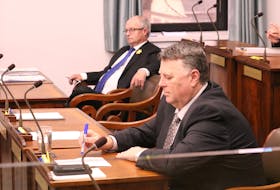The provincial Liberals say they are delivering on a promise — keeping electrical rates from rising to levels that ratepayers on the island can’t afford to pay.
But are they?
The latest plan is a loose collection of buckets where the provincial government expects to be able to find the $726 million it will need every year to keep power rates down.
But how achievable are those targets?
First off, the provincial government is now counting on receiving $200 million every year in dividends from Nalcor, but in the last five years, the company hasn’t had profits of more than $181 million in any given year. The bulk of Nalcor’s revenues come from energy sales, an area that can’t grow profits if electrical prices are held at the current low levels — and other profits depend on oil prices.
Secondly, the Liberal plan depends on $49.1 million a year in surplus energy sales — but profits from the energy marketing division — which handles surplus power sales by the power corporation — haven’t topped $32 million at any time in the last five years. And that money is already part of the firm’s annual profits, so the province would be dipping into the same bucket twice.
First off, the provincial government is now counting on receiving $200 million every year in dividends from Nalcor, but in the last five years, the company hasn’t had profits of more than $136 million in any given year.
Third, the plan involves a $20-million reduction in costs at Nalcor, a move that includes bringing compensation at the company in line with provincial government wage levels. The problem is that $20 million is essentially a 10 per cent cut in Nalcor’s operating costs — remove fixed operating costs, and you have to find $20 million in savings from just $162 million in costs, the bulk of which are $135 million in salaries and benefits. One quick change? That Nalcor will severely cut the $10 million it spends in advertising, donations and community involvement.
Still, the heaviest cuts will end up having to hit salaries.
But it’s not just at Nalcor where the plan has potential hiccups.
The government is also looking at saving $22 million a year by moving away from fossil fuels — but isn’t accounting for the capital cost of making that switch. Another $35.5 million is to come from new large-scale customers and setting up a “competitive” rate for data centres — but those customers want discount power rates.
It’s not clear how selling cheap power — especially if the rate is lower than the production and transmission cost of the power — will help defray the costs for the rest of us.
Finally, there’s the nebulous $200-million benefit we’re supposed to get annually from negotiations with the federal government. We know so little about what’s being looked at there — the two governments say they are going to “consider” things — that it’s hard to even quantify.
So, wait for the hatching.
Because the eggs in this basket aren’t looking so good.









